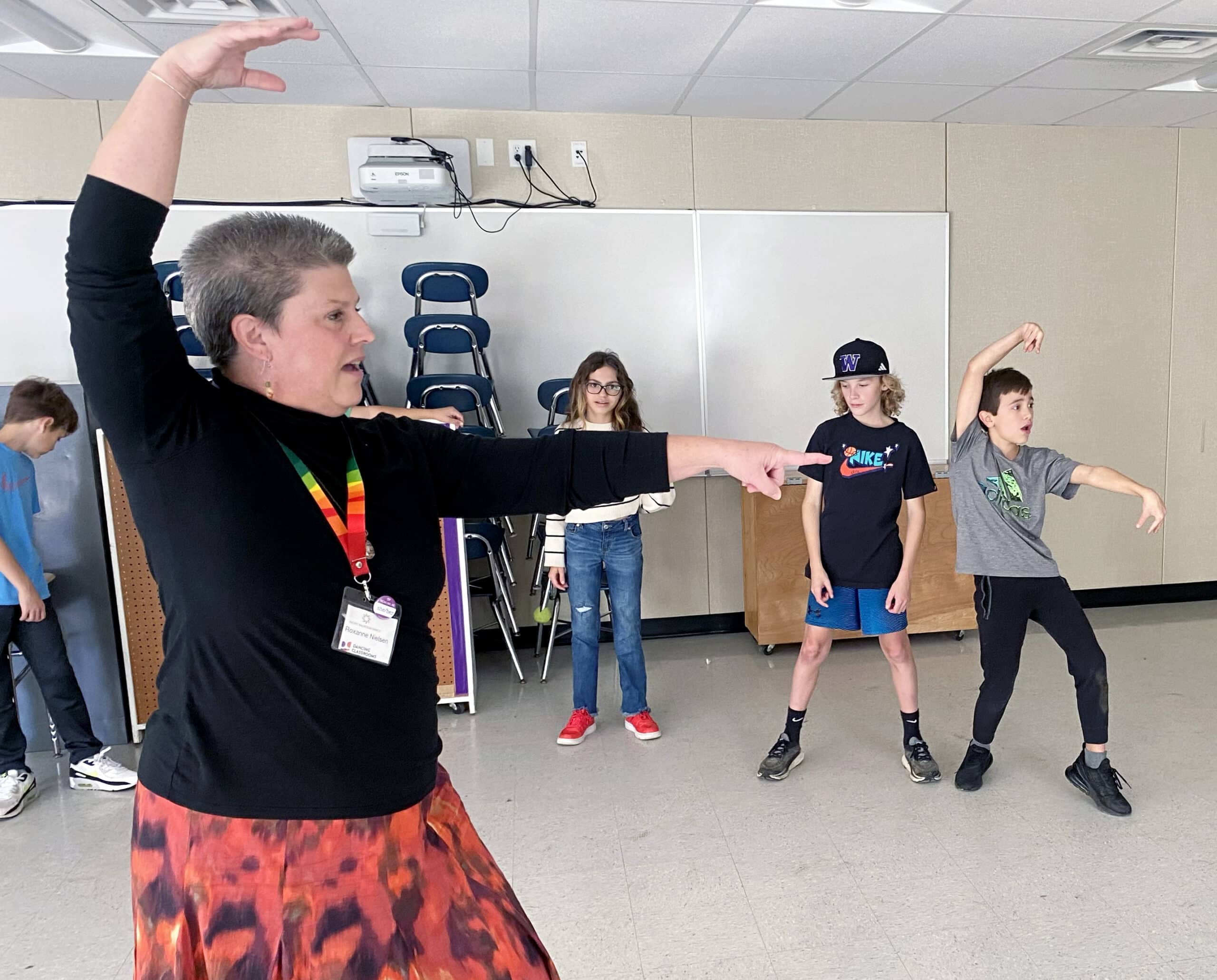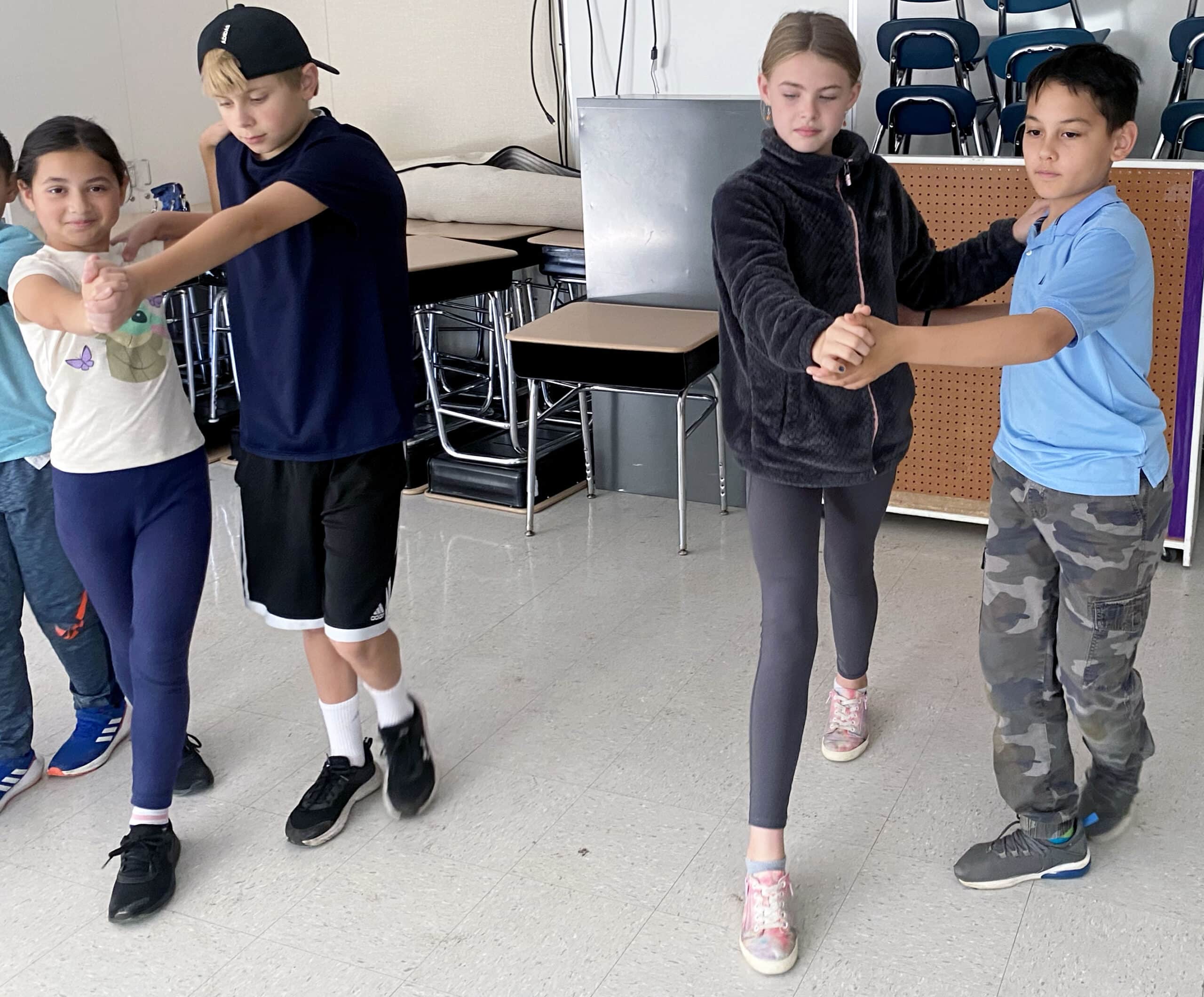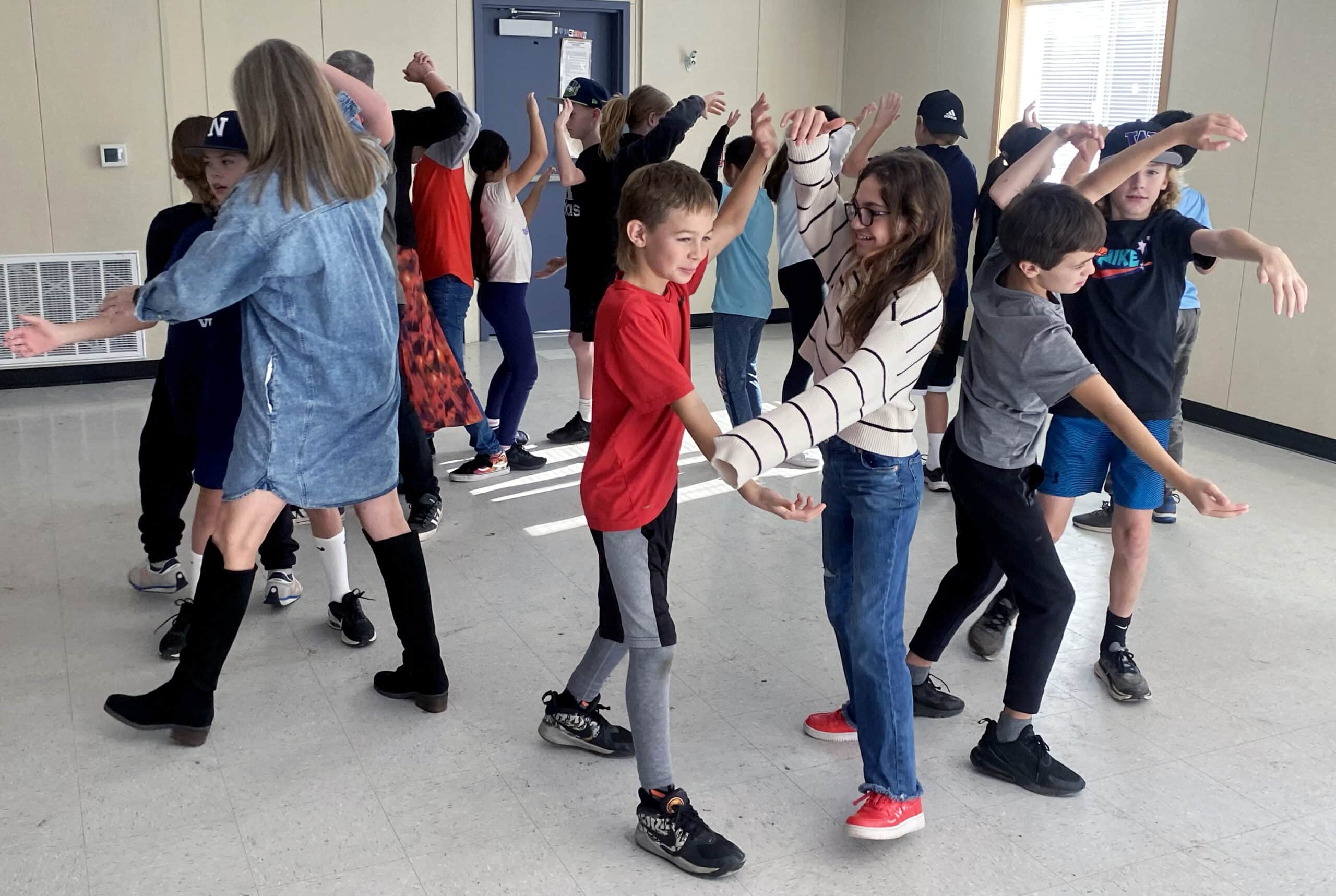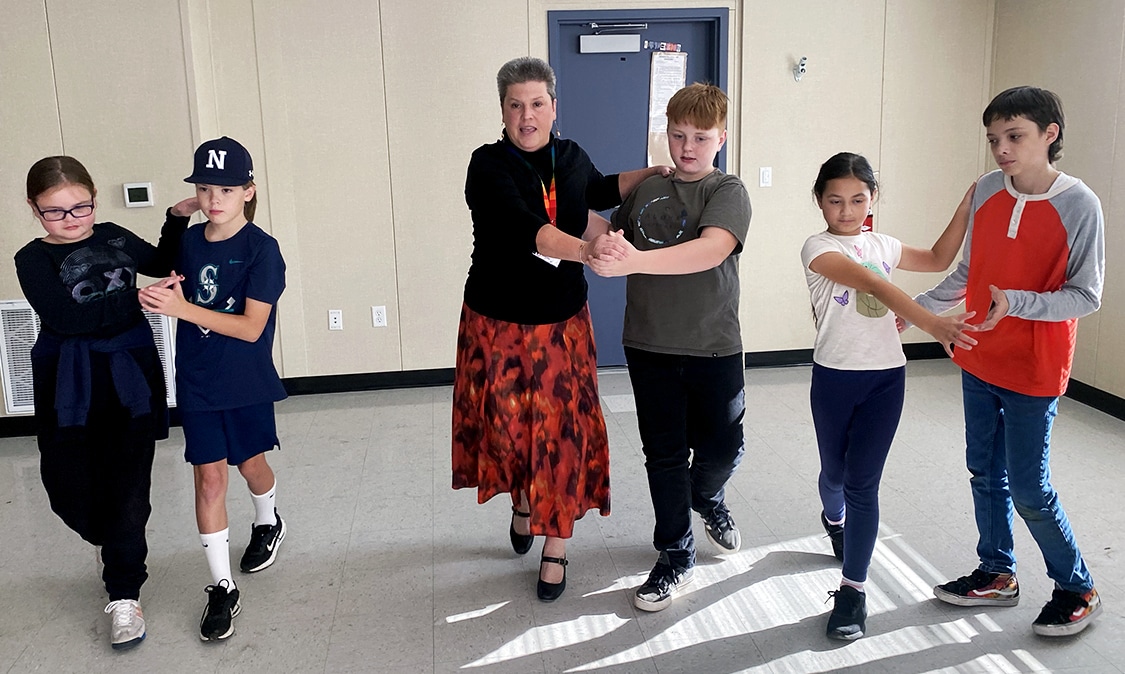Arts & Entertainment Community Education
Elementary students get ready to rhumba with ballroom dance lessons
Sultry tango music plays in a half-empty portable classroom at Voyager Elementary School. Chairs and tables have been pushed aside to create a small dance floor, where students in pairs mark the beat with their feet.
Education Sponsor
Education stories are made possible in part by Tacoma Community College, a proud sponsor of Gig Harbor Now.
Step, step, step, to-the-side and close. “T-A-N-G-O,” calls out instructor Roxanne Nielsen, helping count the rhythm.
It may not be the Savoy, but it’ll do, as this group of fifth graders gets their first taste of ballroom dance. There are more than a few missteps and missed beats. But overall, the students show emerging mastery of the challenging dance, even the dramatic “scorpion” arm.
Ballroom dance lessons in Peninsula School District happen thanks to a partnership with Pacific Ballroom Dance, a nonprofit studio in Auburn whose goal is to “build character in youth through a positive ballroom dance experience.”

Dancing Classrooms instructor Roxanne Nielsen demonstrates the scorpion arm position for the tango during a lesson at Voyager Elementary School on Oct. 30, 2023. Photo by Christina T. Henry
The Gig Harbor Morning Rotary Club provides half of the funding for the program within the district, which has been ongoing (except during the pandemic) for the past eight years. Other costs are covered by the dance studio. The students’ families pay nothing for classes, which are part of the curriculum at participating schools.
The lessons will culminate Dec. 15 with a showcase by students who, 10 weeks earlier, didn’t know what a box step was let alone how to do it.
The joy of dance
The program at Voyager is part of Dancing Classrooms, a nationwide effort to bring the joys (and challenges) of ballroom dance to young people who might not otherwise get that experience. The purpose is to “cultivate essential life skills that include social awareness, confidence and self-esteem in children through the practice of social dance,” according to founder Pierre Dulaine.
“It’s pretty fun, but it gets kind of weird sometimes,” said Voyager student Reagan Starke. “Because we actually have to dance with people. And we can’t pick who we want to. We just rotate, so you have to dance with everybody.”
You actually have to dance with people … Oh, yes, there’s that.
According to Dulaine, speaking in a TED Talk, children (and adults) have become distanced from one another, communicating through texts and social media. Dance has the power to reverse that trend.

Voyager Elementary fifth grade students (from left) Anna Scheuffele and Hawkins Bryant with Carrie Garton and Gideon Cronin practice the tango during a Dancing Classrooms session at the school Oct. 30, 2023. Photo by Christina T. Henry
“My belief is that when a human being dances with another human being, something happens,” Dulaine writes on his website. “You get to know that person in a way you can’t describe.”
“The students are very timid for the first few Dancing Classroom sessions,” said Voyager classroom teacher Lynne Johnson, who participates in the lessons with her students. “Then they start getting more comfortable with each session. They really enjoy learning about the music and dances from other cultures and will even request a dance by name such as the tango.”
Bringing dance to Peninsula schools
Nielsen, whose career began as a theater choreographer, got involved with Dancing Classrooms when she lived in Omaha, Nebraska, the second city outside of New York to adopt the program. She’s now executive director of Pacific Ballroom Dance, which participates in Dancing Classrooms along with its private instruction of students ages 3 through 18, and adults. Many of its students take part in regional and national competitions.
This year, teaching artists from Pacific Ballroom Dance are in fifth grades classrooms twice a week for 10 weeks at schools in Gig Harbor, Enumclaw, Auburn and Federal Way.
Students at Voyager and Minter Creek elementary schools in Peninsula School District are receiving lessons this fall. Winter term, Dancing Classroom instructors will be at St. Nicholas Catholic School in Gig Harbor. This spring, they’ll be at Purdy Elementary.
The availability of Dancing Classrooms in any given school depends mainly on scheduling. Nielsen said her team is working to bring the program to Artondale Elementary and some year, maybe, all schools in the district.
“That’s the dream,” she said.
Dancing around the world
Dulaine started Dancing Classrooms in New York City schools in 1994, chronicled in the documentary “Mad Hot Ballroom” and dramatized in the 2006 film “Take the Lead” with Antonio Banderas. The program at one time was active in more than 30 U.S. cities and five countries.
Dulaine was born Peter Gordon Heney in 1944, in Jaffa (now in Israel). He fled that city at age four with his father (an Irish Protestant) and his mother (a Palestinian Catholic) amid the conflict known by the U.S. State Department as the Arab-Israeli War of 1948. He lived in Jordan, the United Kingdom and later New York City, where he earned acclaim as an award-winning ballroom dancer and teacher.
Dulaine returned to Jaffa in 2011 to teach ballroom dance to Palestinian and Jewish Israeli children, bridging a cultural divide.

Voyager Elementary fifth grade students Henry Nimrick (left) and Marlow Burby practice the tango during a Dancing Classrooms session at the school Oct. 30, 2023. Photo by Christina T. Henry
Ballroom dance bounces back
Time was, ballroom dancing was a widespread pastime. The foxtrot, tango, waltz and rhumba were common cultural knowledge for many people, young and old, with dance halls and ballrooms widely available. So, what happened?
“I think rock and roll happened … (and) people started dancing by themselves,” said Nielsen. “I think the rise of stars like Fred Astaire and Arthur Murray was huge for a while and then that sort of died away.”
But social dance is making a comeback, Nielsen says. Dances hosted by Pacific Ballroom Dance are well-attended by folks from all around the region out for a night of fun. And Dancing Classrooms could be nurturing a whole new generation of ballroom dance afficionados.

Voyager Elementary fifth grade students (from left) Isabella Martinez and Kyler McFarland, dance instructor Roxanne Nielsen with student Carter Partin, and Anna Scheuffele and Karl Brommels practice the tango during a Dancing Classrooms session at the school Oct. 30, 2023. Photo by Christina T. Henry
Why we dance
Dancing is good for the body and the brain, Nielsen said. “There’s a lot of spatial and kinetic things that happen. … You’ve got to count, right? We talk about shapes a lot. There’s rhythm. There’s timing.”
Dancing Classroom teaching artists accommodate students with disabilities.
“The program is inclusive in its nature,” Nielsen said. “So, really nobody is left out, no matter what.”
Dance builds self-confidence, self-respect and respect for others.
“It’s learning that you can step outside your comfort zone and do something really hard and not die from it,” Nielsen said. “It’s learning how to work with other people respectfully that you may not like or typically work with.”
It’s finding out maybe something you thought would be “awkward” (a word commonly used among students) is actually enjoyable.
“And so, for some kids, it becomes a lifelong journey,” Nielsen said.

